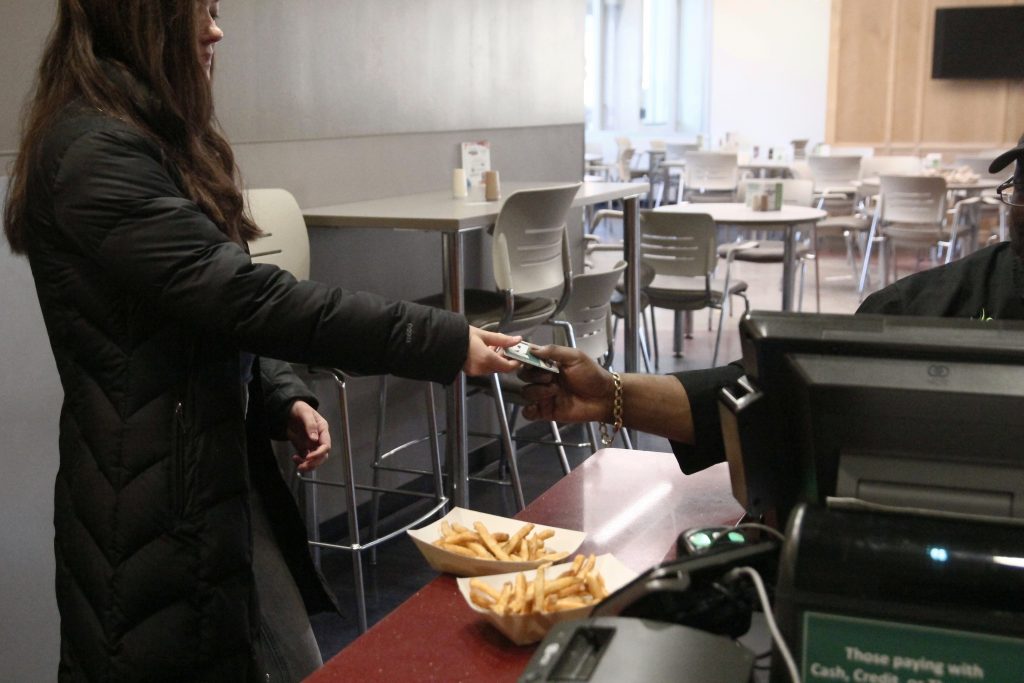While on-campus students are required to use a meal plan, not all students are aware of the ways their money is used.
Meal plan expenses include Dining Dollars that can be used to purchase food and a membership fee. On-campus students, except those who live in Susquehanna Community and Hillside Community, must choose between six different meal plans, ranging from a total cost of $2,890 per semester for Plan A, to $2,186 for Plan F. The built-in membership fee stays the same at $1,709 across the six meal plans, with only the amount of Dining Dollars changing. The off-campus student plans include the commuter plan, at $340 a semester, with $140 going toward the off-campus membership fee.
The default and most common plan for on-campus students is Plan C, costing a total of $2,619 per semester with $910 being allocated as Dining Dollars that can be spent at the three operating student dining halls, College-in-the-Woods Dining Hall, Chenango Champlain Collegiate Center and Appalachian Collegiate Center, as well as retail dining locations such as Jazzman’s and Marketplace vendors.
The $910 is intended to last students a whole semester, but to help students manage their meal plans, there is a University budgeting card, which is posted online and tells students what amount of money they should have left on their meal plan each week. The budgeting card estimates students spend about $60 per a normal school week, with 15 weeks in a typical semester.
John Enright, general manager of resident dining at BU, said BU Dining Services (BUDS) decided on this allotted amount after calculating the average amount spent by students in previous years. He noted roughly 51 percent of students decide to add money to Plan C.
While the way Dining Dollars are spent and how long they last across the semester varies on an individual basis, the membership fee incorporated in the plan is the same for everyone. The membership fee portion of Plan C is $1,709 and accounts for 65.2 percent of the total price. It is allocated toward “labor, supplies, maintenance, utilities and paper,” according to the BUDS website.
Sarah Ludwig, a sophomore majoring in biology, said she is content with her meal plan.
“Despite the slightly rising costs of the plan, I haven’t had an issue with it in any of my semesters yet,” Ludwig said. “I might this semester just because I’ve been eating at the Marketplace a little bit more, but typically it’s been fine.”
The total price of Plan C has increased by 1.5 percent over the last year. As part of the membership fee goes toward labor costs, Enright said the increase correlates with an increased cost of labor and increasing operational costs. He said despite the closing of the Hinman Dining Hall, the operational costs of the remaining three dining halls are still slightly growing each year.
While the allocation of the membership fee goes toward numerous purposes, it explicitly does not go toward is a stealing fee. While many students believe that there is a so-called “stealing fee” built into the meal plan, meant to offset the costs of students taking food and silverware items from dining halls, Enright said no such fee actually exists as part of Plan C, or any other meal plan at BU.
“[BUDS] has no portion of the student meal plan costs going toward this effort,” Enright wrote in an email. “I have been on campus for over 20 years and we have never had a theft fee as part of the meal plan. This has been a myth as long as I’ve been on campus.”
One factor students such as such as Sydney Mendolia, a sophomore majoring in chemistry, consider when using the meal plan is that certain food items cost much more than others, depending on their raw ingredient costs. Enright said the prices of most items are set below a standard retail rate, with BUDS evaluating and establishing new selling prices for items four times a semester, which can result in either increases or decreases of prices. Nevertheless, Mendolia said this pricing policy affects the foods she chooses.
“For the dining halls I feel like the fruit and the salads are so expensive and it shouldn’t be that way because I can get five pieces of fruit for $2 or a bag of french fries for 60 cents, it just doesn’t make sense,” Mendolia said.



